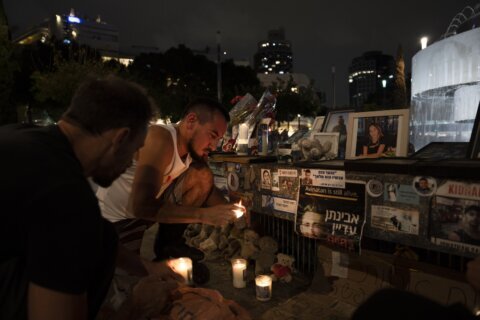KFAR AZA, Israel (AP) — On a sun-dappled day in Kibbutz Kfar Aza, Liora Eilon stood where her son was killed. She picked up a figurine from among the belongings scattered around an abandoned home nearby.
“Every time we come here, Tal leaves us a little message,” the 71-year-old said, turning over the plastic soldier in her hands.
It has been a year since Hamas militants stormed into this community and killed Tal Eilon, 46, the commander of the civilian defense squad.
Liora Eilon now lives in a college dorm in Israel’s north and wonders if she’ll ever return home to this place, seared into Israeli history for that day of mass death, when militants killed some 1,200 people and took around 250 others hostage. The attack sparked an Israeli campaign in Gaza that has killed more than 41,600 Palestinians.
“How can I trust the government who abandoned me here, who betrayed me, promised me that my family was safe here?” she asked.
About 50 of Kfar Aza’s 1,000 residents have returned, living among houses burned by explosives and reduced to rubble.
Others are scattered around the country. The Associated Press spoke to a dozen who shared feelings of vulnerability to future attack and misgivings about Israel’s military, government and Palestinians in Gaza.
Some wondered whether such a place could ever be lived in again.
“Are we going to live inside a memorial? Are we going to see a plaque every few meters, he was killed here and he was killed here?” asked Zohar Shpack, 58.
‘It’s still the seventh of October’
The land still holds traces of the day. Gardener Rafael Friedman still finds teeth and bones in Kfar Aza’s soil — likely remnants of Hamas militants killed in the fighting.
Kfar Aza has always been close-knit. Now photos of slain young people are posted everywhere.
The government says it will rebuild. Meanwhile, it’s constructing pre-fabricated houses for residents in another kibbutz, where two-thirds of the community plan to move.
Some said they weren’t sure they’d ever feel safe returning to Kfar Aza.
They first want to know why it took the military so long to respond to the attack. The military launched an investigation but has not released results. Prime Minister Benjamin Netanyahu has brushed off calls for accountability until war’s end.
Simona Steinbrecher feels too frozen in time to make a decision. Her daughter, Doron, is among 66 Israelis still held captive. Hamas is believed to hold the bodies of 35 others.
The 65-year-old Steinbrecher last saw her daughter in a Hamas propaganda video.
“Without Doron, it’s still the seventh of October,” her mother said. “And we won’t go home until she’s home.”
A military collapse
Many residents of Kfar Aza will boycott the government’s ceremony commemorating Oct. 7. They will instead hold a small tribute and lower the kibbutz flag to half-mast.
Residents said they admire the troops who fought that day but are furious at the military higher-ups, blaming them for a command structure that collapsed when the kibbutz needed it most.
Eilon is gripped with fury and astonishment when recounting the 35 hours of horror her family endured.
When the sirens blared that Saturday morning, Eilon thought it would take the army minutes to arrive. It took hours.
Her family scrambled into their safe room. A son and daughter muscled the door shut against gunmen trying to get inside. Granddaughters, Gali and Mika, hid under the bed. Eilon got a message saying her son Tal had gone out to fight.
The five huddled in the saferoom, hearing the attackers’ shouts and gunfire, not knowing whether Tal was dead or alive. Israeli troops finally gained control of their house.
Still, the troops didn’t evacuate the family. It was only on Sunday afternoon, as militants were hiding out in the house again, that soldiers hustled them out.
As she ran, Eilon saw a tank swivel its cannon at her house. It fired, collapsing her home on the militants inside.
Soon after being rescued, Eilon learned Tal was dead.
“I’d known it all along,” she said. “But some part of me was hoping that he was injured, that he was unconscious in some hospital.”
‘They could have saved them’
As the battle raged, some residents were sped away in army jeeps. Hanan Dann recounted passing soldiers outside the kibbutz, who looked like they were waiting for orders.
“I wanted to say, there’s fighting inside still, there’re people dying,” he said. “They could have saved them.”
Soldiers and militants fought in Kfar Aza for days. In the end, militants killed 64 civilians and 22 soldiers, dragging 19 hostages into Gaza.
Nearby stands a decrepit water tower, a remnant of Be’erot Yitzhak, a kibbutz abandoned after a deadly 1948 Egyptian attack during the war around Israel’s creation.
“Will that be what Kfar Aza looks like 10 years from now?” asked Dann. “Just a stop on the highway I can point out to my kids?”
Even those who want to go back know Kfar Aza will never be the same. Shpack said he understands why no one would bring a child here.
“Even once the bombs end, how can you raise him here? How do you explain what happened here?”
For some, the kibbutz’s fate is tied to Gaza. As long as there is no peace agreement with Palestinians, they say they’ll find themselves again under attack.
Eilon wants a new government that will talk to the Palestinians to find “some arrangement for us to live together on the same land.”
“I’m dreaming for the day with an open fence from here to the sea, with two people living together.”
Copyright © 2024 The Associated Press. All rights reserved. This material may not be published, broadcast, written or redistributed.






